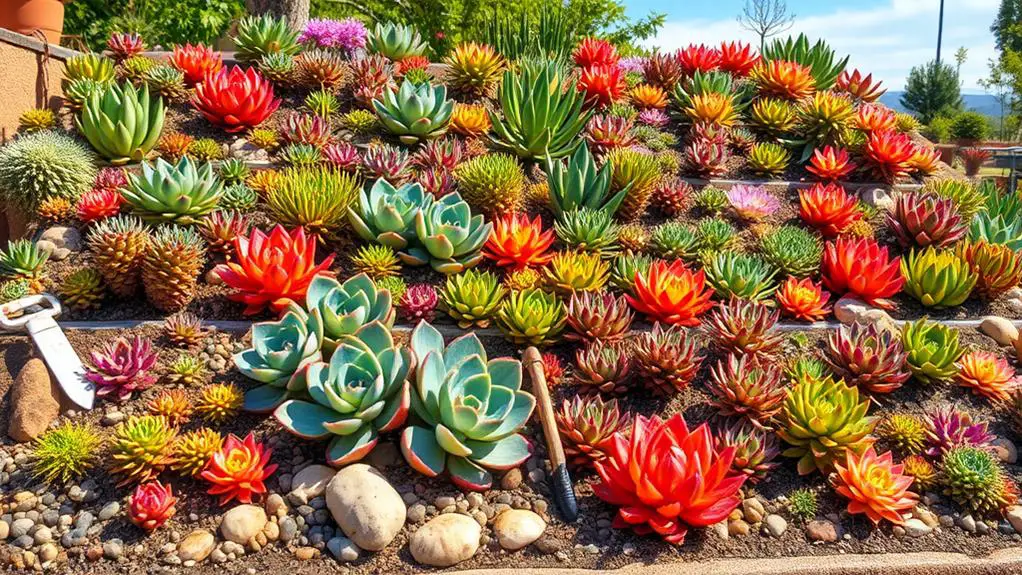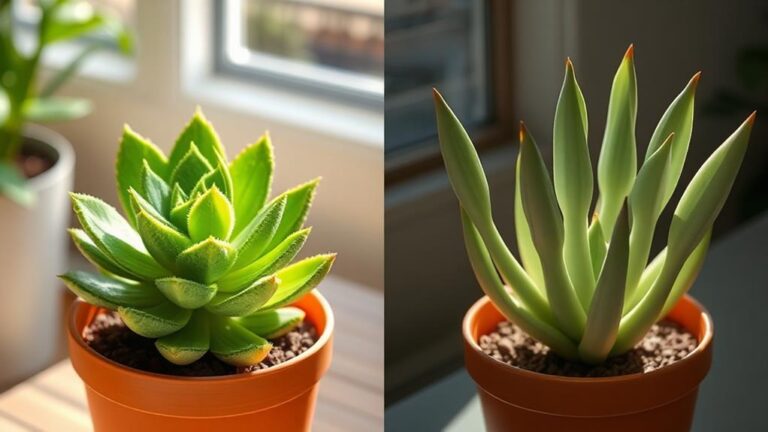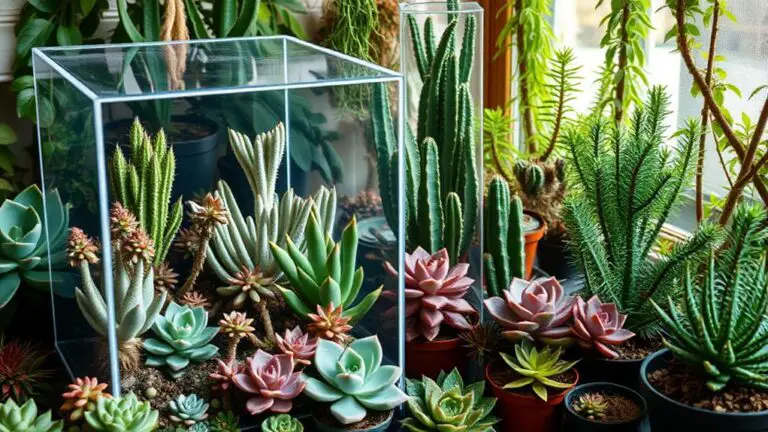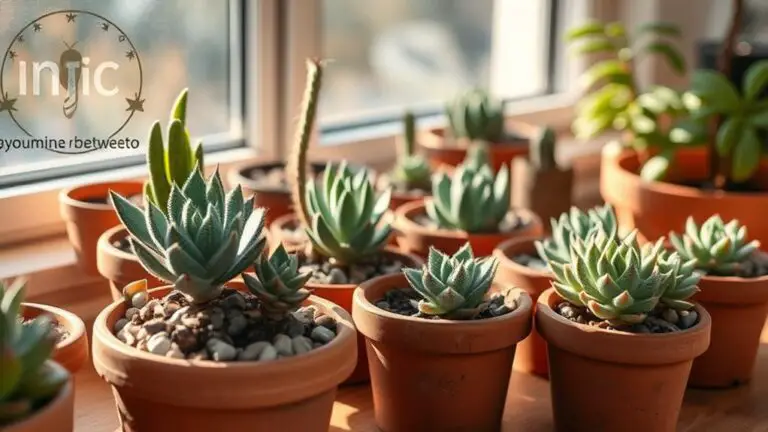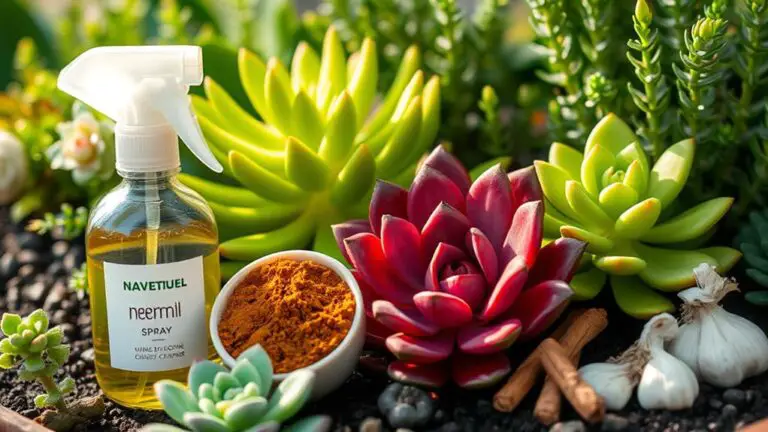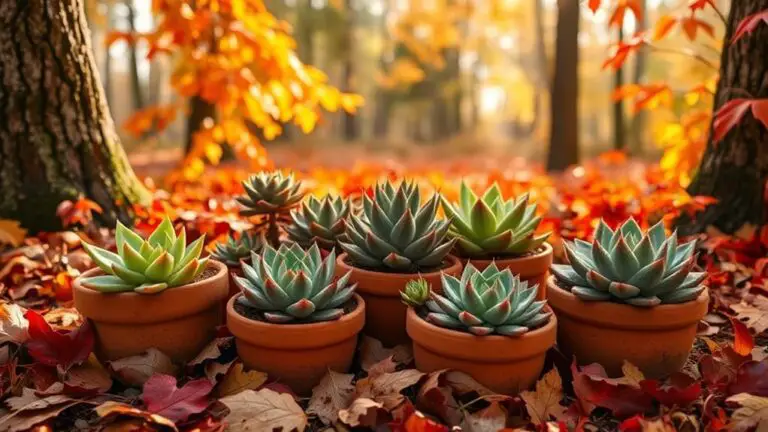7 Steps to Create a Beautiful Succulent Garden
Starting a succulent garden might seem intimidating, but by following seven straightforward steps, you can transform any space into a lush, vibrant oasis. You'll begin by selecting the perfect location with ample indirect sunlight and preparing the soil to guarantee proper drainage. Once you've chosen a variety of succulents, arranging them thoughtfully will enhance their natural beauty. Adding decorative elements can elevate the garden's visual appeal. Finally, consistent maintenance will keep your garden thriving. Are you ready to discover the detailed steps to create a stunning succulent garden that will be the envy of your neighborhood?
Select the Right Location
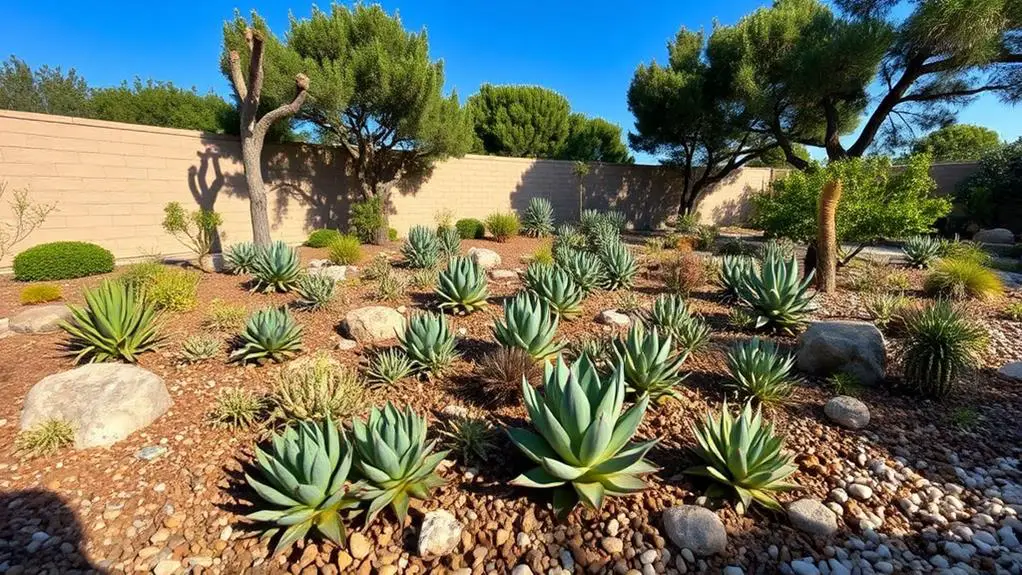
Finding the perfect spot for your succulent garden is essential for guaranteeing healthy growth. You'll want to choose a location that gets 6-8 hours of bright, indirect sunlight daily. This amount of light helps your succulents thrive and stay strong.
Ideal places include mantels, desks, or kitchen tables. These spots not only brighten up your decor but also guarantee your plants get the light they need.
Avoid placing your succulent garden near heating or cooling vents. Extreme temperature changes can stress your plants, making it harder for them to grow well. Consistent temperatures are key.
Also, think about humidity. High humidity or areas with frequent moisture can increase the risk of root rot. Root rot is when the roots sit in water too long and start to decay. To prevent this, opt for drier locations in your home.
Remember to rotate your succulent garden regularly. Turning your plants guarantees they get even light exposure, so they don't stretch or lean toward the light source.
Gather Essential Materials
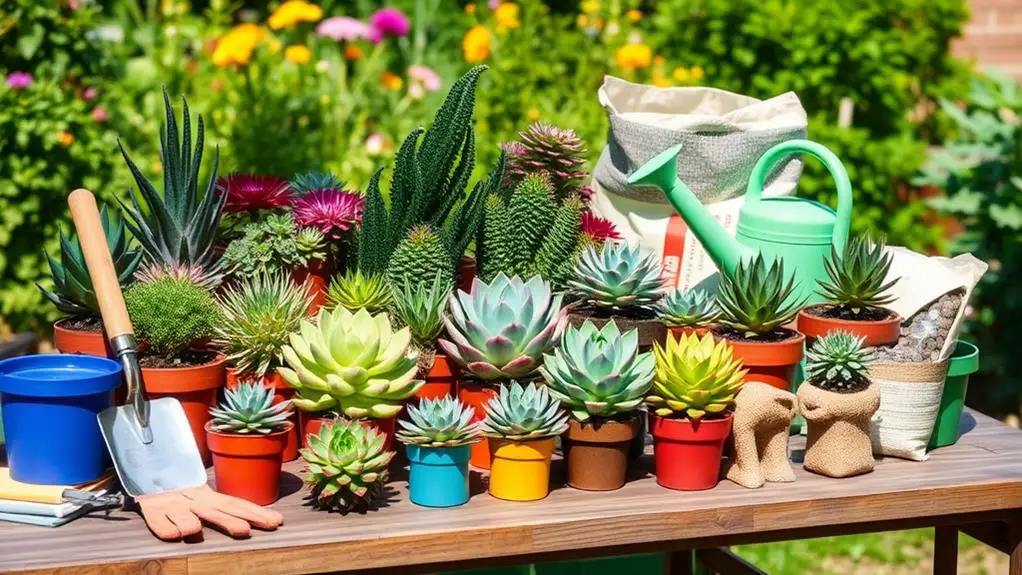
Now that you've found the perfect spot for your succulent garden, it's time to gather essential materials.
Start with a large container that has drainage holes to prevent waterlogging, and add small pebbles or gravel for a drainage layer.
Don't forget activated charcoal for air filtration, a soil mix designed for succulents, and some decorative elements like river rocks or sand to make your garden look stunning.
Necessary Soil Elements
Creating a thriving succulent garden starts with understanding the necessary soil elements and gathering essential materials.
Begin by guaranteeing good drainage, which is vital for preventing root rot. Start with a layer of small pebbles at the bottom of your container. This helps water flow freely. Next, add a layer of activated charcoal. It filters the air, keeps the soil fresh, and reduces odors.
For the soil mix, you'll need quick-draining soil designed specifically for succulents. You can buy pre-packaged succulent soil or make your own by mixing 2 parts potting soil with 1 part sand. This blend guarantees the soil doesn't retain too much moisture.
It's important to regularly check your soil's drainage. Pour water into the soil and see how fast it drains. If it pools or drains slowly, add more sand or pumice to improve its texture.
Choosing Right Tools
Selecting the right tools and materials is vital for setting up your succulent garden. Start by choosing a large container with drainage holes. Good draining is important to prevent root rot, which can harm your succulents.
Next, gather small pebbles to create a base layer at the bottom of your container. This will help with effective water drainage.
You'll also need activated charcoal, which filters the air and absorbs impurities. This keeps your succulent garden healthy and thriving.
When it comes to soil, pick a well-draining mix. You can use a pre-packaged succulent soil or make your own by mixing 2 parts potting soil with 1 part sand. This guarantees that water succulents get the right amount of moisture without becoming waterlogged.
Don't forget to take into account some decorative items like river rocks. While we'll explore more into decorations later, adding a few now can enhance the visual appeal of your succulent garden using these rocks to define plant areas.
Decorative Accessories Selection
After gathering the right tools and materials, you can start focusing on decorative accessories to elevate your succulent garden's aesthetic.
Start by selecting a variety of decorative containers. Terrariums, Mason jars, or unique bowls can add charm, but make sure they've proper drainage holes to prevent waterlogged roots.
Enhance your garden's visual appeal by incorporating top dressing. Decorative elements like river rocks, gravel, or colored sand can add color and help with moisture retention.
To add a personalized touch, use miniature props such as figurines or themed decor items. These little details make your garden more engaging and fun.
Consider adding natural elements for an earthy look. Items like moss or small boulders can provide texture and create a more organic feel.
When choosing accessories, always keep plant health in mind. Select items that support the well-being of your succulents, like moisture-absorbing crystals or breathable mesh for drainage.
Here's a quick checklist to guide you:
- Decorative containers with drainage holes
- Top dressing such as river rocks or gravel
- Miniature props for personalized touches
Choose Your Succulents

Choosing the right succulents is essential for a thriving garden, so it's best to start with varieties that have similar lighting and watering needs.
Beginner-friendly options like Sedum, Sempervivum, Kalanchoe, and Echeveria offer a range of colors and shapes.
Remember to group them by growth habits and consider their size and growth rates to create a balanced and beautiful arrangement.
Popular Succulent Varieties
When creating your succulent garden, it's important to explore the popular varieties that offer unique aesthetics and benefits.
Let's plunge into some favorites:
- Hen and Chicks: These fast-growing succulents produce multiple rosettes, providing a variety of colors and shapes. They're ideal for adding visual interest to your garden.
- Jelly Bean: Also known as Pork and Beans, these succulents change colors with the seasons. They start green in summer, then turn vibrant orange/red in fall, and yellow in spring. This makes them a dynamic addition to any arrangement.
- Desert Rose: This succulent showcases a distinctive bulb-like stem and produces beautiful pink, white, or red flowers. However, be cautious, as its sap is toxic.
For those looking for easy propagation, Jade Plants are a great choice with their thick, fleshy leaves. They're particularly easy to grow from cuttings.
Another excellent option is Aloe Vera, which isn't only beautiful but contains over 75 nutrients, making it beneficial for health and wellness.
Lighting and Water Needs
Why is proper lighting and watering vital for your succulent garden? The right lighting and water needs are critical for succulents to thrive. Most succulents need 6-8 hours of bright, indirect sunlight each day.
Morning sunlight is best since it's less intense than the afternoon rays, which can cause sunburn on the leaves. If your space has low light, choose succulents like Haworthia and Gasteria that don't require as much sun.
Watering is just as important. Succulents prefer their soil to dry out completely between waterings. Typically, 1/4 cup of water weekly works well, but you may need to adjust based on the season and climate.
Overwatering can lead to mushy, translucent leaves, while underwatering may cause shriveled, dehydrated leaves. Regular potting soil isn't ideal; instead, use soil designed for succulents, which provides better drainage.
When picking succulents, consider their specific light and water needs. Grouping them accordingly guarantees they don't compete for resources, helping them flourish.
Size and Growth Rates**
Considering the size and growth rates of succulents is essential to designing a balanced and visually appealing garden. Some succulent plants, like Agave, can grow quite large, while others, such as Echeveria, stay small and compact. This means you need to plan carefully to guarantee each plant has enough space to thrive.
Fast-growing succulents, like Hen and Chicks, can quickly fill in gaps and create a lush garden more rapidly. However, it's important to group succulents with similar growth rates together. This way, faster-growing plants won't overshadow the slower ones, maintaining visual balance. For instance, Aloe Vera can grow up to 2 feet tall, but Jelly Bean (Pork and Beans) typically stays around 6 inches.
Here are three key steps to help you arrange your succulents effectively:
- Check the mature size of each plant to guarantee they've enough space to grow.
- Monitor growth rates and group plants with similar speeds together.
- Regularly adjust spacing and arrangements to prevent overcrowding and promote healthy development.
Prepare the Soil
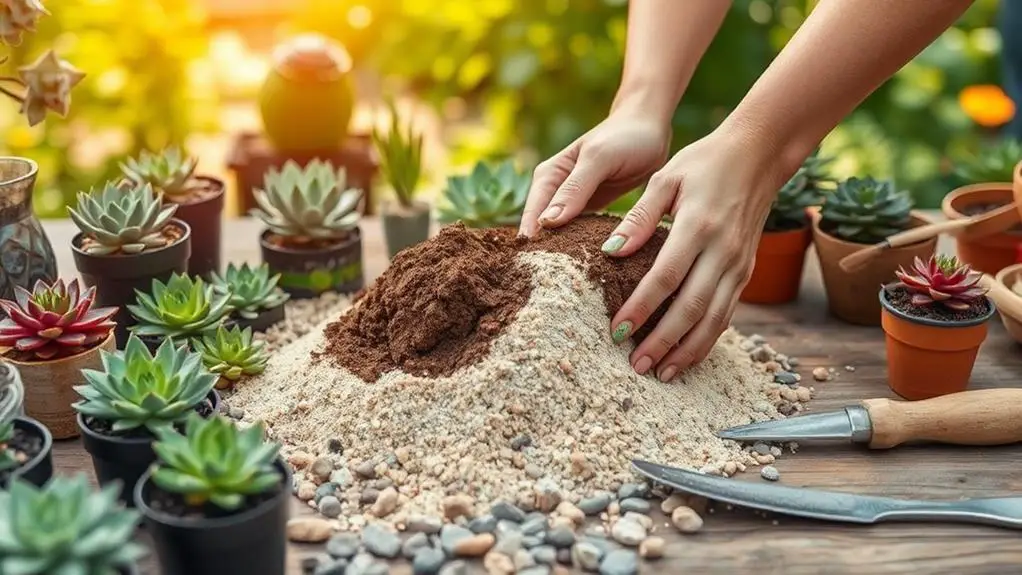
To guarantee your succulent garden thrives, start by selecting a large pot with drainage holes to prevent waterlogging. This step is essential for ensuring healthy root growth.
Next, you need to prepare the soil properly. Begin by adding a base layer of small pebbles, about 1-2 inches thick, to improve the drainage. This setup helps excess water flow away from the root systems, reducing the risk of root rot.
After the pebbles, add a layer of activated charcoal. This not only filters the air but also prevents odors in the soil.
For the main soil layer, use a well-draining soil mix specifically designed for succulents. If you prefer a DIY approach, blend 2 parts potting soil with 1 part sand. This combination encourages healthy root development by promoting a draining soil environment.
It's important to adjust the soil composition as needed. Make sure it contains at least 60% non-organic material like pumice or perlite. These materials enhance drainage considerably, ensuring your succulents don't sit in water.
With these steps, you'll have a perfect foundation for your succulent garden, setting the stage for robust and thriving plants.
Plant the Succulents
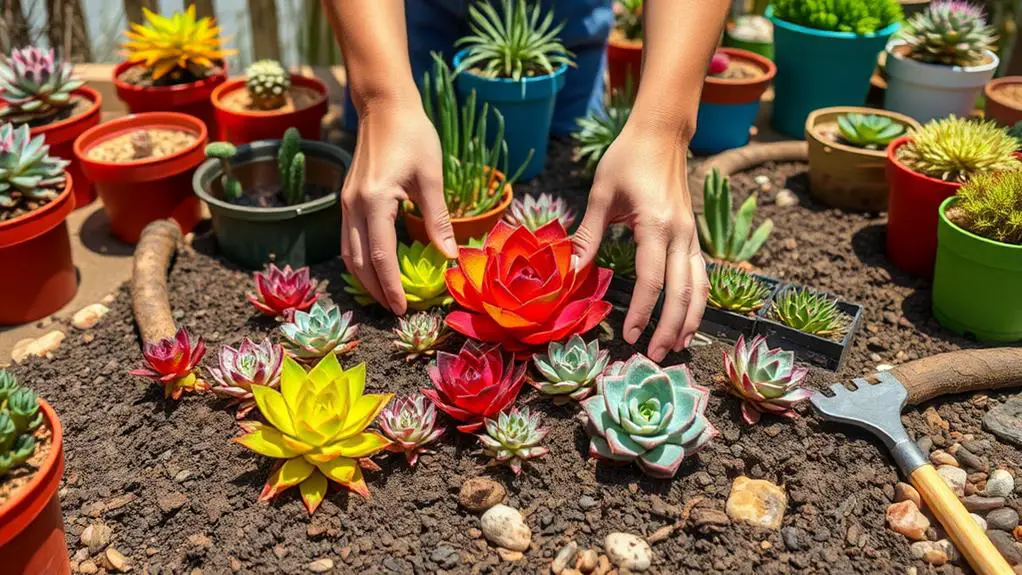
With the soil prepared, it's time to plant your succulents. Start by gently separating any compacted roots from the root ball. This promotes healthy growth and encourages root expansion.
Next, arrange your succulents in the container. Position them according to their height and color for a visually appealing layout, guaranteeing each plant is spaced 1-2 inches apart.
When planting, make certain the succulents are planted at the same depth as they were in their previous pots. This helps prevent root rot, as succulents prefer to be planted shallowly to guarantee the soil drains well.
Fill in the gaps around the plants with well-draining soil, gently pressing it down to secure the succulents in place.
To help you remember the key steps, here's a quick list:
- Gently separate the root ball to encourage root growth.
- Arrange succulents by height and color for visual appeal.
- Fill gaps with well-draining soil to avoid root rot.
After planting, lightly mist the garden to settle the soil, but avoid overwatering. Succulents thrive in dry conditions, so they don't need much water.
Add Decorative Elements
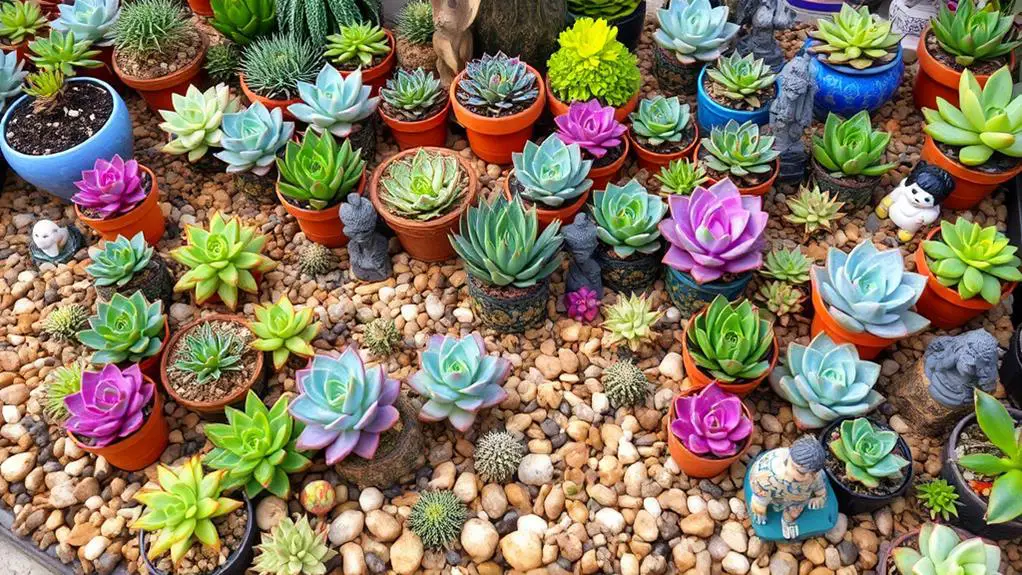
Enhancing your succulent garden with decorative elements not only adds visual interest but also allows you to express your personal style.
Start by incorporating miniature props like tiny figurines or decorative stones. These whimsical touches can create a fun theme and make your garden more engaging.
You can also add larger decorative elements such as boulders or seashells. These items provide focal points and introduce texture, making your garden more dynamic and eye-catching.
Placing moss around the base of your plants not only adds a lush green contrast but also helps retain moisture in the soil, keeping your succulents healthy.
Another way to enhance your succulent garden is by using decorative top dressing. Colored gravel or sand can define different areas of your garden and give it a clean, polished look.
This simple step adds a professional finish to your arrangement.
Maintain and Care
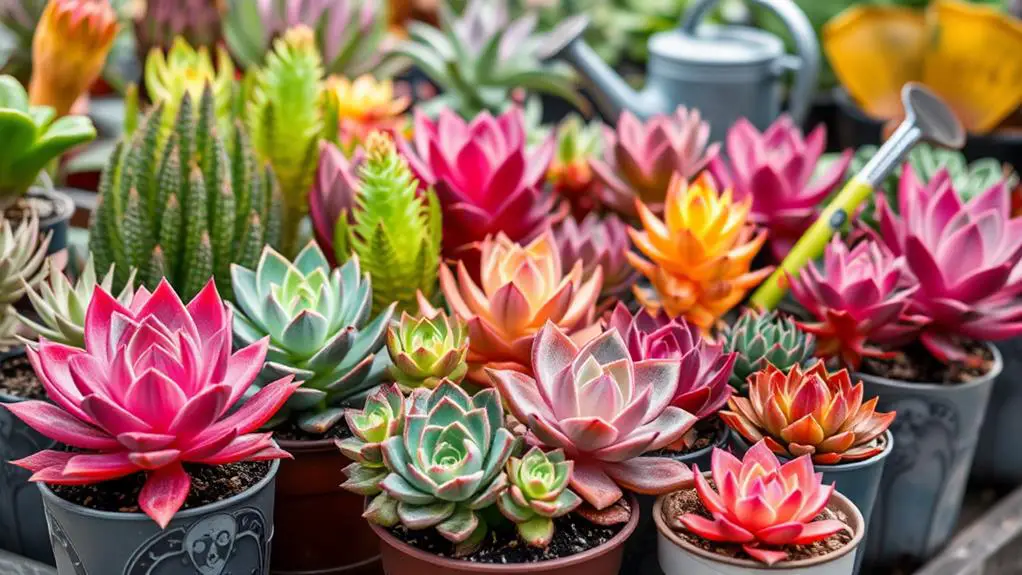
Maintaining and caring for your succulent garden involves a few key practices to guarantee your plants thrive.
First, let's talk about watering. Succulents need a specific amount of water to stay healthy. Typically, watering once a week is enough, but make sure the soil dries out completely between waterings. This prevents root rot and overwatering issues.
Next, lighting is essential. Succulents indoors require at least 6-8 hours of bright indirect sunlight each day. Direct harsh sunlight can cause leaf burn, so be mindful of where you place your plants.
To maintain plant health, consider these care tips:
- Fertilize sparingly: Use a low-balanced fertilizer during the growing season. Too much can damage your plants.
- Check for pests: Regularly inspect your succulents for signs of pests like mealybugs. Remove any dead leaves to improve air circulation.
- Adjust for seasonal changes: Water less during cooler months and monitor environmental factors like humidity and temperature.
Frequently Asked Questions
How to Make a Beautiful Succulent Garden?
To make a beautiful succulent garden, select diverse succulents, guarantee proper drainage, and use well-draining soil. Arrange them thoughtfully with decorative elements. Water sparingly and place in bright, indirect sunlight, rotating regularly for even light exposure.
How to Organize a Succulent Garden?
Group succulents by their watering and sunlight needs. Space smaller ones 1-2 inches apart for growth. Use a variety of colors and textures, and add decorative elements. Rotate the garden regularly for even light exposure.
How Do You Prep a Succulent Garden?
You start by choosing a well-draining container with holes. Layer pebbles and activated charcoal for drainage and odor control. Use a succulent soil mix, gently separate roots, and arrange plants by size and light needs.
How Do You Make Beautiful Succulent Arrangements?
Choose succulents with varying colors and textures for visual interest. Group them by light and water needs. Use decorative elements like river rocks to enhance aesthetics. Arrange by height for balance and experiment with themed designs for uniqueness.
Conclusion
You've got all the steps to create a stunning succulent garden. Remember, choose a sunny spot, prepare well-draining soil, and pick succulents that you love. Plant them carefully and add some fun decorations to make it your own. Don't forget to water them just right and keep an eye on your garden's health. With a bit of care and attention, you'll have a beautiful succulent garden that'll thrive and impress everyone who sees it. Happy gardening!

